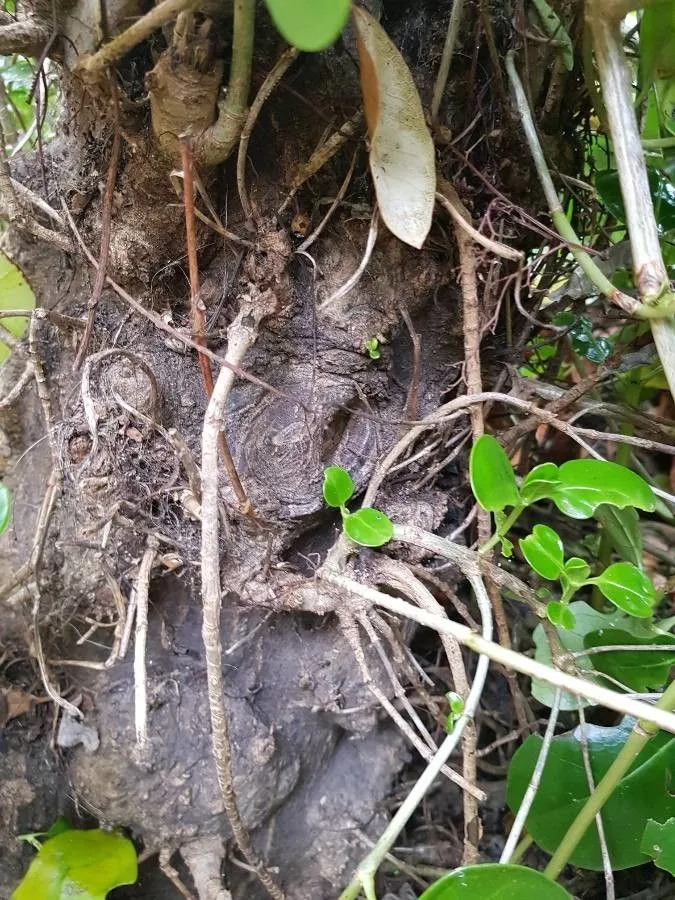
Author: A.Rich.
Bibliography: J.S.C.Dumont d’Urville, Voy. Astrolabe 1: 264 (1832)
Year: 1832
Status: accepted
Rank: species
Genus: Coprosma
Vegetable: Unknown
Observations: New Zealand
Plant Profile: Creeping Mirrorplant
The Creeping Mirrorplant, scientifically known as Coprosma repens, is a distinguished member of the Rubiaceae family, native to the picturesque landscapes of New Zealand. Known for its robust adaptability and unique aesthetic appeal, this plant plays a vital role in both natural and cultivated settings.
Coprosma repens is a hardy evergreen shrub that exhibits a creeping growth habit, hence its common name, Creeping Mirrorplant. The name “Mirrorplant” derives from its vibrant, glossy leaves which reflect light, creating a mirror-like effect. These leaves are typically oval-shaped, dark green, and can take on a metallic hue, particularly in sunlight. A prominent feature of the Creeping Mirrorplant is its dense and bushy foliage, providing a lush appearance year-round.
In its native habitat of New Zealand, Coprosma repens thrives in coastal environments, often found clinging to cliffs and shores where other vegetation may struggle. Its resilience to harsh winds and salty conditions makes it an excellent choice for coastal gardens and areas subjected to extreme weather.
Gardeners prize the Creeping Mirrorplant for its durability and low maintenance requirements. It grows well in a range of soil types, from sandy to loamy, and can tolerate both full sun and partial shade. Its creeping nature makes it ideal for ground cover, stabilizing soil in erosion-prone areas, and providing a dense mat of greenery. Additionally, it can be pruned to maintain a desired shape and size, adding versatility in landscaping uses.
Beyond its ornamental value, Coprosma repens is utilized in horticulture for several practical purposes:
– Ground Cover: Prevents soil erosion and suppresses weeds due to its thick, spreading growth.
– Hedge Planting: Its dense foliage makes it suitable for creating windbreaks and privacy screens.
– Container Gardening: Can be grown in pots and containers, adding visual interest to patios and urban gardens.
The formal scientific study and classification of Coprosma repens were conducted by the French explorer and naturalist J.S.C. Dumont d’Urville during his voyage on the Astrolabe. The plant was documented in 1832 in the first volume of his voyage’s publication. Renowned botanist A. Rich was responsible for authoring the classification, further solidifying its place in botanical literature.
In addition to its decorative and functional uses, the Creeping Mirrorplant plays a crucial role in its native ecosystem. It provides habitat and food for various bird species and insects, contributing to the biodiversity and ecological balance within its environment.
Coprosma repens, or the Creeping Mirrorplant, is a remarkable plant that combines aesthetic beauty with practical benefits. Its ability to thrive in challenging conditions, coupled with its attractive appearance and ease of care, makes it a versatile and valuable addition to gardens worldwide. Enthusiasts and horticulturists alike continue to appreciate the myriad qualities of this resilient New Zealand native.
Eng: creeping mirrorplant, new zealand mirrorbush, tree bedstraw, looking-glass-bush, looking-glass-plant, mirrorplant, tree-bedstraw
Swe: skimmerkoprosma
Cym: coprosma
En: Creeping mirrorplant, New Zealand mirrorbush, Tree Bedstraw, Looking-glass-bush, Looking-glass-plant, Mirrorplant, Tree-bedstraw
Sv: Skimmerkoprosma
Cy: Coprosma
Taken Jun 2, 2020 by anna Randell (cc-by-sa)
Taken Jul 30, 2020 by Delanie (cc-by-sa)
Taken Oct 5, 2021 by Heron Ash (cc-by-sa)
Taken Oct 15, 2020 by luke McMartin (cc-by-sa)
Taken Oct 15, 2020 by luke McMartin (cc-by-sa)
Taken Aug 2, 2022 by Iryna Vynogradna (cc-by-sa)
Taken Jan 27, 2021 by Jan Firth (cc-by-sa)
Taken Jan 27, 2021 by Jan Firth (cc-by-sa)
Taken Nov 6, 2020 by parra nelson (cc-by-sa)
Taken Oct 15, 2020 by luke McMartin (cc-by-sa)
Taken Oct 25, 2022 by Sonia Neto (cc-by-sa)
Taken Apr 19, 2022 by Janine Zschech (cc-by-sa)
Taken Aug 12, 2021 by jimmy andres Zamora (cc-by-sa)
Taken Oct 20, 2021 by Julian Schmitt (cc-by-sa)
Taken May 21, 2021 by Fernández Manuel (cc-by-sa)
© copyright of the Board of Trustees of the Royal Botanic Gardens, Kew.
Taken Feb 27, 2021 by Pereira Jorge (cc-by-sa)
Taken Oct 7, 2021 by Mary Graham (cc-by-sa)
Taken Sep 22, 2022 by geta tanase (cc-by-sa)
Family: Myrtaceae Author: (F.Muell.) K.D.Hill & L.A.S.Johnson Bibliography: Telopea 6: 402 (1995) Year: 1995 Status:…
Family: Rubiaceae Author: Pierre ex A.Froehner Bibliography: Notizbl. Bot. Gart. Berlin-Dahlem 1: 237 (1897) Year:…
Family: Sapindaceae Author: Koidz. Bibliography: J. Coll. Sci. Imp. Univ. Tokyo 32(1): 38 (1911) Year:…
Family: Asteraceae Author: A.Gray Bibliography: Pacif. Railr. Rep.: 107 (1857) Year: 1857 Status: accepted Rank:…
Family: Fabaceae Author: Medik. Bibliography: Vorles. Churpfälz. Phys.-Ökon. Ges. 2: 398 (1787) Year: 1787 Status:…
Family: Aspleniaceae Author: (Cav.) Alston Bibliography: Bull. Misc. Inform. Kew 1932: 309 (1932) Year: 1932…